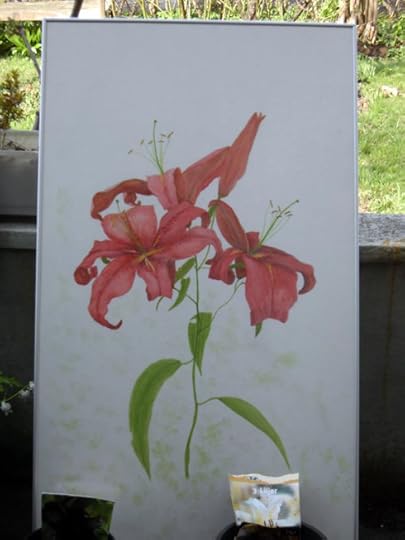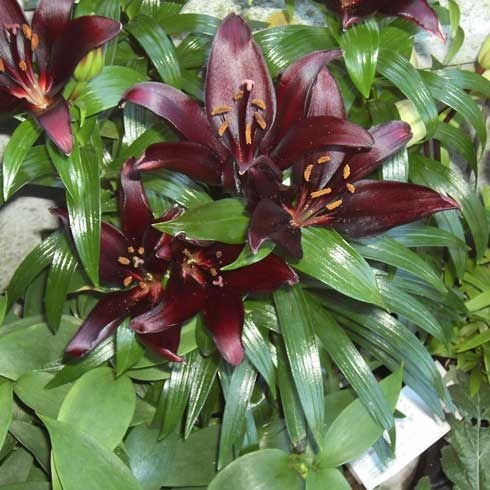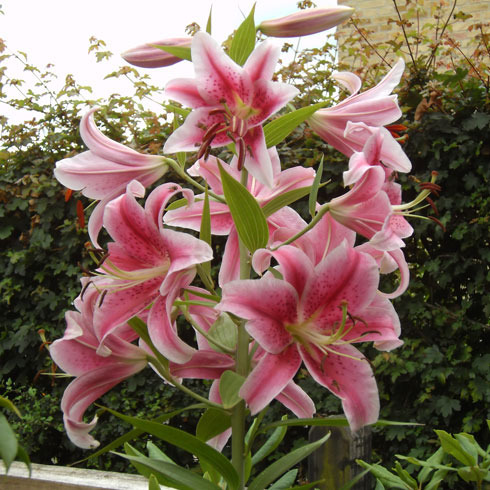Growing Lilies in Pots – guest post by Anette
I’ve been growing lilies in pots for more than three decades. When living in apartments they grew on windowsills from start to finish, but even now that I also grow them in my garden, there are advantages to the pots.
My primary reason is that I draw them – type: botanic illustration in watercolor and crayon – and a flower still on its roots does not change its shape as quickly as a cut flower, so I need not work quite so fast. Other main reasons are that pots make it easier to give the various lily-species the type of soil they prefer, and that the pots may be moved around and placed wherever I prefer them – indoors and out.

Red oriental lily, bought as Stargazer, but with no white border on the petals
Growing lilies in pots is easy. Basically you just plumb the bulbs in, surround them with soil, give them some water, and they handle the rest. If that’s all you do, they do, however, tend to be annuals or at least not flower much after their first season, but with even minimum care of water and fertilizer, most types will flower for 3-5 years. Once they are down to one or two flowers per stem, I usually plant them in the back garden, and some will recover and go on there for decades.
I like to keep 5-10 pots going per season, so most years I buy new bulbs for 1-3 pots. Some years I go for 1-3 good quality bulbs of a named hybrid from a reliable nursery. These planted together will make a luxurious decoration for weeks at the price of a single bouquet from a florist. Other years I just buy a bag or two of “mixed hybrids” from the rack at the local grocery, and plant them one by one in any pot or container, to use for painting models, presents, or just decorations.
Both the cheap and the expensive bulbs I buy tend to belong to one of three groups of lilies: Asian, Trumpet or Oriental. There are other kinds, incl. Lilium longiflorum with the slim, white trumpet flowers often grown to decorate the churches, but my three stalwarts are both the easiest to find and the easiest to grow.

Asian lily, Landini, have no fragrance, but the most beautiful glossy leaves and dark flowers
The easiest – and earliest – of the three are the Asians. You simply place your bulbs on 5-10 cm (2-4”) ordinary potting soil in a pot with drainage holes, cover with about 10 cm (4”) of the same soil, and water when dry. About 2 months later you’ll have upwards and outwards facing bowl or star shaped flowers at the top of a sturdy 1-2′ stem narrow, fresh green leaves. One of the easiest and most popular is the old orange ‘Enchantment’, but the colors of the flowers may be anything from pale cream, rosy or primrose yellow, over intense golden or orange, to deep dark mahogany red. Asian Lilies rarely have much fragrance, but unless placed directly in burning sun, the flowering lasts 2-3 weeks.
Trumpet Lilies are the offspring of the old fragrant, white Royal Lily, Lilium regale. They’re grown just like the Asian Lilies, but have taller, more spindly stems, that often need a cane – especially if grown on a windowsill where there’s less light than outdoors. When in full bloom it might also be necessary to cover the surface of the pots with stones to keep the weight from tipping it over. The trumpet name comes from the longer, less open flowers some of which face outwards, some of which are hanging. The leaves also tend to be slightly narrower, but that’ll vary. There are a few Trumpet Lilies with deep colors such as the deep yellow African Queen, and the dusky pink Pink Perfection, but most have fairly pale colors in shades of white, pink or yellow, and nearly all are fragrant enough for a single flowering plant to fill a living room with as much perfume as anyone could want.

Oriental lily, Journey’s End – and it smell heavenly!
The late flowering Oriental Lilies are often the most fragrant of all lilies, but while they are still easy to grow compared with many other flowers, they do insist on a few basic perks. First, they are acid lovers and must be grown in chalk-free soil of the kind used for rhododendrons. Second, they very much dislike having their bulbs baked by the sun, so the pots should never be placed in full sun. Thirdly, most – such as the very pretty Stargazer – need about a month more to grow before blooming than the Asians and Trumpets. These things aside the bulbs of the Oriental Lilies should be treated exactly the same as the other lilies, and will shoot up a 45-75 cm (1.5-2.5′) stem with leaves broader than the other types, and ending with a spray of white and pink or red star-shaped flowers set on short side-stems.
Finally a few tips:
1. If your bulbs are completely dormant with no sign of sprouting when you want to plant them, it’s a good idea to either give the bulbs a week in the refrigerator before potting or to place the potted bulbs outdoors for 1-2 weeks.
2. Lilies in pots are not normally troubled with diseases and pests, but the lacquer red lily beetle (looks like an elongated ladybird without spots) sometimes finds your lilies even in their pots. The beetles don’t normally like pots, as they survive by dropping to the ground and burrowing when in danger. If, however, you see one, just let it drop into your hand or onto a trowel, drop it on a paving stone and stomp on it. Then look at the underside of the lily leaves for any of the tiny orange eggs or the – very dirty – black larvae, and remove those. I just pick off the leaves, but in my experience the only type likely to attract the beetles is the broad leaved Orientals, which I often keep standing in a corner of the garden waiting for them to flower after the summer holiday.
Anette, the Great Dane
Robin McKinley's Blog
- Robin McKinley's profile
- 7225 followers



